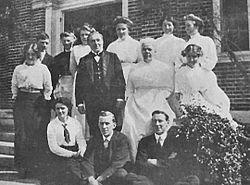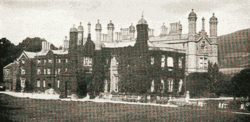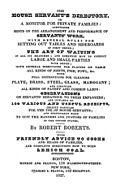Butler facts for kids

A butler is a male domestic worker in a large household with several employees.
The butler is the chief servant, responsible for the day-to-day management of the house and the other servants. In a traditional house the butler, who is always male, directs the male servants, while a housekeeper, a woman, directs the female servants. Traditionally, male servants (such as valets and footmen) were better paid and of higher status than female servants.
Contents
Background
The word "butler" comes from Anglo-Norman buteler, variant form of Old Norman *butelier, corresponding to Old French botellier "officer in charge of the king's wine bottles", derived of boteille "bottle", Modern French bouteille, itself from Gallo-Romance BUTICULA "bottle". The role of the butler, for centuries, has been that of the chief steward of a household, the attendant entrusted with the care and serving of wine and other bottled beverages which in ancient times might have represented a considerable portion of the household's assets.
In Britain, the butler was originally a middle-ranking member of the staff of a grand household. In the 17th and 18th centuries, the butler gradually became the senior, usually male, member of a household's staff in the very grandest households. However, there was sometimes a steward who ran the outside estate and financial affairs, rather than just the household, and who was senior to the butler in social status into the 19th century. Butlers used always to be attired in a special uniform, distinct from the livery of junior servants, but today a butler is more likely to wear a business suit or business casual clothing and appear in uniform only on special occasions.
A silverman or silver butler has expertise and professional knowledge of the management, secure storage, use and cleaning of all silverware, associated tableware and other paraphernalia for use at military and other special functions. See also Silver (household).
To butler (verb): To butler, to dispense wines or liquors; to act as a butler (simple past and past participle butlered).
Origin and history
The modern role of the butler has evolved from earlier roles that were generally concerned with the care and serving of alcoholic beverages.
Ancient through medieval eras
From ancient through medieval times, alcoholic beverages were chiefly stored first in earthenware vessels, then later in wooden barrels, rather than in glass bottles; these containers would have been an important part of a household's possessions. The care of these assets was therefore generally reserved for trusted slaves, although the job could also go to free persons because of heredity-based class lines or the inheritance of trades.
The biblical book of Genesis contains a reference to a role precursive to modern butlers. The early Hebrew Joseph interpreted a dream of Pharaoh's שקה (shaqah) (literally "to give to drink"), which is most often translated into English as "chief butler" or "chief cup-bearer".
In ancient Greece and Rome, it was nearly always slaves who were charged with the care and service of wine, while during the Medieval Era the pincerna], filled the role within the noble court. The English word "butler" itself comes from the Middle English word bo(u)teler (and several other forms), from Anglo-Norman buteler, itself from Old Norman butelier, corresponding to Old French botellier ("bottle bearer"), Modern French bouteiller, and before that from Medieval Latin butticula. The modern English "butler" thus relates both to bottles and casks.
Eventually the European butler emerged as a middle-ranking member of the servants of a great house, in charge of the buttery (originally a storeroom for "butts" of liquor, although the term later came to mean a general storeroom or pantry). While this is so for household butlers, those with the same title but in service to the Crown enjoyed a position of administrative power and were only minimally involved with various stores.

Elizabethan through Victorian eras
The Steward of the Elizabethan era was more akin to the butler that later emerged. Gradually, throughout the 19th century and particularly the Victorian era, as the number of butlers and other domestic servants greatly increased in various countries, the butler became a senior male servant of a household's staff. By this time he was in charge of the more modern wine cellar, the "buttery" or pantry (from French pan from Latin panis, bread) as it came to be called, which supplied bread, butter, cheese, and other basic provisions, and the ewery, which contained napkins and basins for washing and shaving. In the very grandest households there was sometimes an Estate Steward or other senior steward who oversaw the butler and his duties. Mrs Beeton's Book of Household Management, a manual published in Britain in 1861, reported:
The number of the male domestics in a family varies according to the wealth and position of the master, from the owner of the ducal mansion, with a retinue of attendants, at the head of which is the chamberlain and house-steward, to the occupier of the humbler house, where a single footman, or even the odd man-of-all-work, is the only male retainer. The majority of gentlemen's establishments probably comprise a servant out of livery, or butler, a footman, and coachman, or coachman and groom, where the horses exceed two or three.
Butlers were head of a strict service hierarchy and therein held a position of power and respect. They were more managerial than "hands on"—more so than serving, they officiated in service. For example, although the butler was at the door to greet and announce the arrival of a formal guest, the door was actually opened by a footman, who would receive the guest's hat and coat. Even though the butler helped his employer into his coat, this had been handed to him by a footman. However, even the highest-ranking butler would "pitch in" when necessary, such as during a staff shortage, to ensure that the household ran smoothly, although some evidence suggests this was so even during normal times.
The household itself was generally divided into areas of responsibility. The butler was in charge of the dining room, the wine cellar, pantry, and sometimes the entire main floor. Directly under the butler was the first footman (or head footman), although there could also be a deputy butler or under-butler who would fill in as butler during the butler's illness or absence. The footman—there were frequently numerous young men in the role within a household—performed a range of duties including serving meals, attending doors, carrying or moving heavy items, and they often doubled as valets. Valets themselves performed a variety of personal duties for their employer. Butlers engaged and directed all these junior staff and each reported directly to him. The housekeeper was in charge of the house as a whole and its appearance. In a household without an official head housekeeper, female servants and kitchen staff were also directly under the butler's management, while in smaller households, the butler usually doubled as valet. Employers and their children and guests addressed the butler (and under-butler, if there was one) by last name alone; fellow servants, retainers, and tradespersons as "Mr. [Surname]".
Butlers were typically hired by the master of the house but usually reported to its lady. Beeton in her manual suggested a GBP 25–50 (USD 2,675–5,350) per-year salary for butlers; room and board and livery clothing were additional benefits, and tipping known as vails, were common. The few butlers who were married had to make separate housing arrangements for their families, as did all other servants within the hierarchy.
Butlers in early United States
From the beginning of slavery in the United States, in the early 17th century, African Americans were put to task as domestic servants. Some eventually became butlers. Gary Puckrein, a social historian, argues that those used in particularly affluent homes authentically internalised the sorts of "refined" norms and personal attributes that would reflect highly upon the social stature of their masters or mistresses. One of the first books written and published through a commercial U.S. publisher by an African American was by a butler named Robert Roberts. The book, The House Servant's Directory, first published in 1827, is essentially a manual for butlers and waiters, and is called by Puckrein "the most remarkable book by an African American in antebellum America". The book generated such interest that a second edition was published in 1828, and a third in 1843.
European indentured servants formed a corps of domestic workers from which butlers were eventually drawn. Although not the victims of institutionalised slavery, many of them had not volunteered for domestic service, but were forced into it by indebtedness or coercion. As with African American slaves, they could rise in domestic service, and their happiness or misery depended greatly on the disposition of their masters.
The modern butler
Beginning around the early 1920s (following World War I), employment in domestic service occupations began a sharp overall decline in western European countries, and even more markedly in the United States. Even so, there were still around 30,000 butlers employed in Britain by World War II. As few as one hundred were estimated to remain by the mid-1980s. Social historian Barry Higman argues that a high number of domestic workers within a society correlates with a high level of socio-economic inequality. Conversely, as a society undergoes levelling among its social classes, the number employed in domestic service declines.
Following varied shifts and changes accompanying accelerated globalisation beginning in the late 1980s, overall global demand for butlers since the turn of the millennium has risen dramatically. According to Charles MacPherson, President of Charles MacPherson Associates and owner of The Charles MacPherson Academy for Butlers and Household Managers, the proximate cause is that the number of millionaires and billionaires has increased in recent years, and such people are finding that they desire assistance in managing their households. MacPherson emphasises that the number of wealthy people in China has increased particularly, creating in that country a high demand for professional butlers who have been trained in the European butlering tradition. There is also increasing demand for such butlers in other Asian countries, India, and the petroleum-rich Middle East.
Higman additionally argues that the inequality/equality levels of societies are a major determinant of the nature of the domestic servant/employer relationship. As the 21st century approached, many butlers began carrying out an increasing number of duties formerly reserved for more junior household servants. Butlers today may be called upon to do whatever household and personal duties their employers deem fitting, in the goal of freeing their employers to carry out their own personal and professional affairs. Professional butler and author Steven M. Ferry states that the image of tray-wielding butlers who specialise in serving tables and decanting wine is now anachronistic, and that employers may well be more interested in a butler who is capable of managing a full array of household affairs—from providing the traditional dinner service, to acting as valet, to managing high-tech systems and multiple homes with complexes of staff. While in truly grand houses the modern butler may still function exclusively as a top-ranked household affairs manager, in lesser homes, such as those of dual-income middle-class professionals, they perform a full array of household and personal assistant duties, including mundane housekeeping. Butlers today may also be situated within corporate settings, embassies, cruise ships, yachts, or within their own small "Rent-a-Butler" business or similar agency.
Along with these changes of scope and context, butlering attire has changed. Whereas butlers have traditionally worn a special uniform that separated them from junior servants, and although this is still often the case, butlers today may wear more casual clothing geared for climate, while exchanging it for formal business attire only upon special service occasions. There are cultural distinctions, as well. In the United States, butlers may frequently don a polo shirt and slacks, while in Bali they typically wear sarongs.
In 2007, the number of butlers in Britain had risen to an estimated 5,000.
The period drama, Downton Abbey, has been credited as the reason for a sudden upsurge in the demand for 'properly trained butlers'.
Training
Butlers traditionally learned their position while progressing their way up the service ladder. For example, in the documentary The Authenticity of Gosford Park, retired butler Arthur Inch (born 1915) describes starting as a hall boy. While this is still often the case, numerous private butlering schools exist today, such as The British Butler Institute, and top graduates can start at US$50,000–60,000 (£25,350–30,400). Additionally, major up-market hotels such as the Ritz-Carlton offer traditional butler training, while some hotels have trained a sort of pseudo-butler for service in defined areas such as "technology butlers", who fix guests' computers and other electronic devices, and "bath butlers" who draw custom baths. In addition to formal training, a few books have been published to assist butlers in their duties, including Arthur Inch's and Arlene Hirst's 2003 Dinner is Served. Moreover, websites, as well as a news publication, Modern Butlers' Journal, help butlers to network and keep abreast of developments within their field.
Gender and butlering
Butlers have traditionally been male, and this remains the norm. Probably the first mention of a female butler is in the 1892 book Interludes being Two Essays, a Story, and Some Verses by Horace Smith. In it Smith quotes a certain Sydney Smith who had apparently run into lean times:
A man servant was too expensive, so I caught up a little garden girl, made like a milestone, christened her Bunch, put a napkin in her hand, and made her my butler. The girls taught her to read, Mrs. Sydney to wait, and I undertook her morals. Bunch became the best butler in the country.
Today, female butlers are sometimes preferred, especially for work within Middle and Far Eastern families where it may be religiously problematic for men to work closely with women in a household. Western female celebrities may also prefer a female butler, as may households where the wife is driving the decision to hire a butler. In 2004, Buckingham Palace announced it was actively recruiting women for the position. Despite these trends, the Ivor Spencer School asserts that female butlers are not easily placed, on the whole.
The Charles MacPherson Academy for Butlers and Household Managers reports that 40% of the students admitted into its program are women. The school goes on to report that the labour market still has a preference for male butlers, however, the market is becoming more progressive and increasing numbers of female butlers are being hired.
In ancient times, the roles precursive to butlering were reserved for chattel or those confined within heredity-based class structures. With the advent of the medieval era, butlering became an opportunity for social advancement—even more so during Victorian times. Although still based upon various antecedent roles as manifested during different eras, butlering today has frequently taken over many of the roles formerly reserved for lower-ranking domestic servants. At the same time it has become a potentially lucrative career option.
Images for kids
-
A butler in the White House Butler's Pantry.








